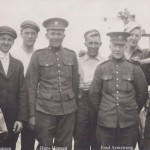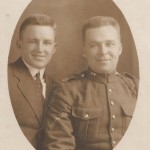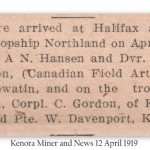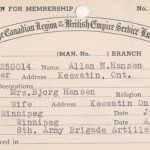

| Personal Details | |
| Date of Birth | October 27, 1894 |
| Place of Birth | Keewatin, Ontario |
| Country | Canada |
| Marital Status | Single |
| Next of Kin | Nelson Hansen (father), Keewatin, Ontario |
| Trade / Calling | Clerk |
| Religion | Methodist |
| Service Details | |
| Regimental Number | 1250014 |
| Service Record | Link to Service Record |
| Battalion | 8th Brigade |
| Force | Canadian Expeditionary Force |
| Branch | Canadian Field Artillery |
| Enlisted / Conscripted | Enlisted |
| Address at Enlistment | Keewatin, Ontario |
| Date of Enlistment | June 7, 1916 |
| Age at Enlistment | 21 |
| Theatre of Service | Europe |
| Prisoner of War | No |
| Survived War | Yes |
| Death Details | |
| Date of Death | 19800229 |
| Age at Death | 85 |
| Buried At | Lake of the Woods Cemetery, Kenora, Ontario |
| Plot | 58E-11-1, Memory Meadow Block |
Hansen, Allan Nelson
Gunner Allan Nelson Hansen enlisted in 1916 and spent two years overseas with the Canadian Field Artillery. Three of his brothers also served in the war.
Allan was the son of Nils (Nels) Julius Hansen and his wife Ellen Nilson. Nils and Ellen both immigrated to Canada in the 1880s, Nils from Norway and Ellen from Sweden. They were married in December 1888 in Winnipeg and a short time later they moved to Keewatin in northwestern Ontario. Nils was involved in the construction of the flour mill in Keewatin and he had a long career with the Lake of the Woods Milling Company. By the 1920s he was superintendent of the flour mill’s heating and sprinkler systems. He was also very active in community affairs and he served on the Keewatin town council in 1920 and as Keewatin’s mayor in 1921.
Nils and Ellen had seven children, their daughter Cleora (1890), followed by six sons: Hans, Allan, Carl, John, Frederick and Clarence. Allan, the third oldest, was born in Keewatin on 27 October 1894. When he enlisted in 1916 he was working as a clerk at Fife’s Hardware Store. He signed up in Winnipeg on 6 June 1916, joining the 76th Depot Battery, Canadian Field Artillery. Just two months later he suffered a broken clavicle and he spent nine days in St. Boniface Hospital. The 76th was a reinforcement depot and recruits were sent overseas in drafts as needed. After training over the fall and winter Allan was sent to the UK as part of the Depot’s 3rd draft, arriving in England on 22 April 1917. He spent two more months training with reserve batteries before being sent to France at the end of June and transferred to a new unit, the Ammunition Column of the 8th Army Brigade, Canadian Field Artillery.
Massive amounts of artillery were used in the war and ammunition columns were responsible for bringing artillery shells and other supplies to the batteries in the forward areas. On return trips they brought back unused ammunition and salvageable material like spent shell casings. Horses and mules were the main means of transport and most of the work was done at night. When Allan joined the 8th Brigade in August 1917 they were based near Lens in France, supporting the Canadian Corps at the Battle of Hill 70. Two months later they were in Belgium for the assault on Passchendaele, where the Canadians fought in horrendous conditions. In mid-December the 8th Brigade moved back south and joined the Canadian Corps in the Lens area again, where they stayed until the following summer.
In March 1918 Allan had two weeks leave in Paris. At the end of June he became ill, suffering from a fever, and he some spent time in a hospital and convalescent centre. He was diagnosed with bronchitis in July and admitted to a hospital in Le Tréport, on the coast of France. His brother Carl was a patient there at the same time. When Allan recovered he was posted to the Canadians Corps Reinforcement Camp and it was late October before he rejoined his unit in the field. They had just moved into Belgium and a few days later, on 11 November, the Armistice was signed. The 8th Brigade spent three more months in Belgium and in January 1919 Allan had another two week leave. His unit entrained for Le Havre in mid-February and returned to England on 2 March. They left for Canada on HMT Northland at the end of the month, arriving in Halifax on 5 April. The men were discharged in Winnipeg four days later.
Three of his brothers also served: Hans with the 52nd Battalion, Carl in the Canadian Field Artillery and John with the 34th Fort Garry Horse. John died of illness in Winnipeg at age 19, while he was in training, but Hans and Carl survived the war.
After his discharge Allan returned to Keewatin and he was honoured at a ceremony there on 4 August 1919, when veterans and the families of fallen soldiers were awarded medals. When the 1921 census was taken he was living in Keewatin with his parents, sister and three brothers and working in a confectionery. He was married in Selkirk, Manitoba on 24 July 1930 to Bjorg (Buddy) Davidson. Buddy’s parents had emigrated from Iceland and she was born and raised in Selkirk, where her father worked as a tinsmith. In November 1930 Allan’s father and brother Frederick both died of pneumonia. His mother passed away a year and a half later.
Allan was employed as the assessor and tax collector for the Town of Keewatin from 1932 until he retired in 1964. He was an honorary life member of the Keewatin Curling Club and a member of the Keewatin branch of the Canadian Legion. He passed away on 29 February 1980 in Winnipeg, where he’d been living for a short time. He was survived by his wife and their son Alan and he’s buried in Lake of the Woods Cemetery in Kenora.
Allan, Carl, Hans and John are commemorated on the Municipality of Keewatin ‘For King and Country’ 1914-1918 Honour Roll.
By Becky Johnson
Photos provided by Marnie (Hansen) Karlberg.












